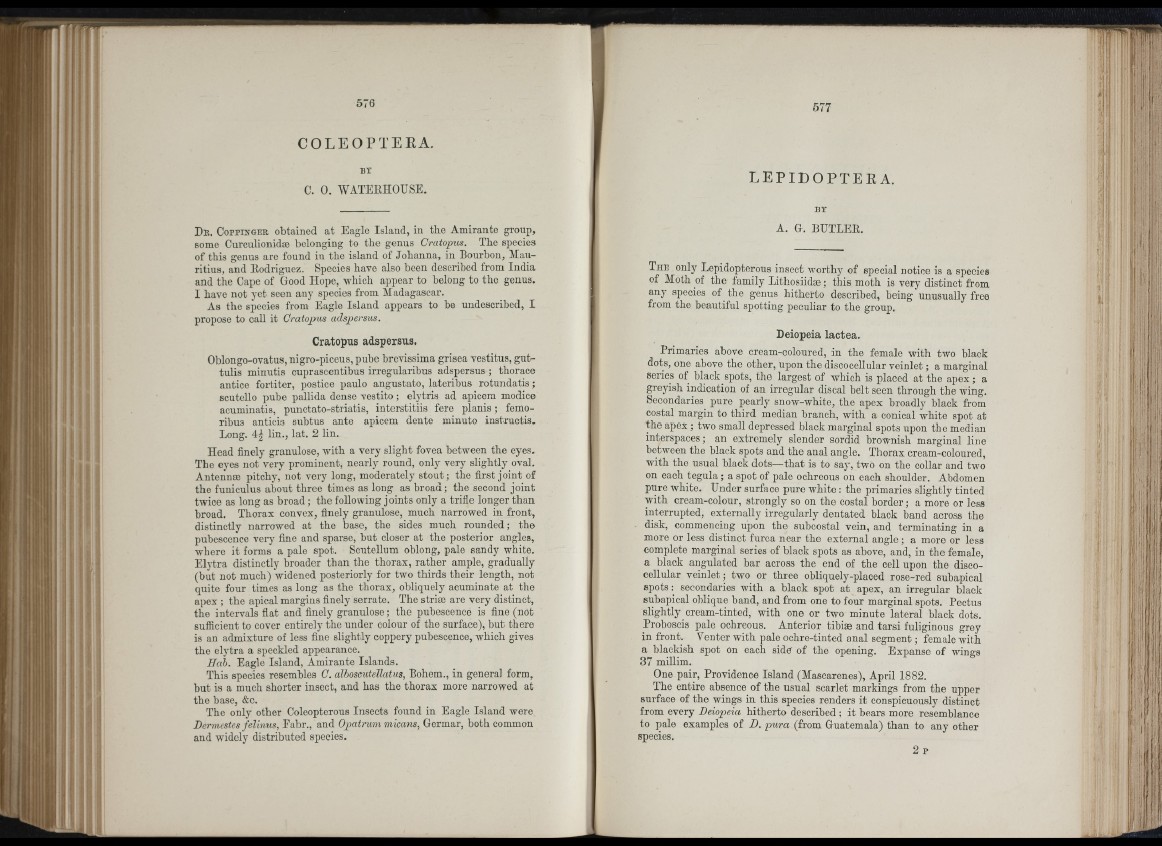
i: I
COL EOP T ERA.
BY
C. 0 . WATEEHOUSE.
Dr. C o p p in g e r obtained a t Eagle Island, in tbe Amirante group,
Bome Curculionidas belonging to tbe genus Cratopus. Tbe species
of tbis genus are found in tbe island of Jobanna, in Bourbon, Mauritius,
and Eodriguez. Species bave also been described from India
and the Cape of Good Hope, whicb appear to belong to the genus.
I bave not yet seen any species from Madagascar.
As the species from Eagle Island appears to be undescribed, I
propose to call it Cratopus adspersus.
Cratopus adspersus.
Obiongo-ovatus, nigro-piceus, pube brevissima grisea vestitus, giit-
tulis minutis cuprascentibus irregularibns adspersus ; tborace
antice fortiter, postice paulo angustato, lateribus rotundatis ;
scutello pube pallida dense vestito ; elytris ad apicom modice
acuminatis, piinctato-striatis, interstitiis fere planis ; femo-
ribiis anticis snbtus ante apicem dente minuto instructis.
Long. 4^ lin., lat. 2 lin.
Head finely granulose, witb a very slight fovea between the eyes.
The eyes not very prominent, nearly round, only very slightly oval.
Antennæ pitchy, not very long, moderately stout ; the first joint of
tbe funiculus about three times as long as broad; the second joint
twice as long as broad ; the foUowing joints only a trifle longer than
broad. Thorax convex, finely granulose, much narrowed in front,
distinctly narrowed at the base, tbe sides mucb rounded; the
pubescence very fine and sparse, but closer at the posterior angles,
where it forms a pale spot. Scutellum oblong, pale sandy white.
Elytra distinctly broader than the thorax, ratber ample, gradually
(but not much) widened posteriorly for two thirds their length, not
quite four times as long as tbe thorax, obliquely acuminate at tbe
apex ; the apical margins finely serrate. The striæ are very distinct,
the intervals flat and finely granulose ; the pubescence is fine (not
sufficient to cover entirely tbe under colour of tbe surface), but there
is an admixture of less fine slightly coppery pubescence, wbicb gives
tbe elytra a speckled appearance.
Hah. Eagle Island, Amirante Islands.
Tbis species resembles C. alhoscutellatus, Bohem., in general form,
but is a mucb shorter insect, and has tbe thorax more narrowed at
the base, &c.
The only other Coleopterous Insects found in Eagle Island were
Dermestes felinus, Fabr., and Opatrum micans, Germar, botb common
and widely distributed species.
L E P ID O P T E E A .
BY
A. G. BUTLEE.
T he only Lepidopterous insect worthy of special notice is a species
of Moth of the family Litbosiida?; this moth is very distinct from
an j species of the genus hitherto described, being unusually free
from tbe beautiful spotting peculiar to the group.
Deiopeia lactea.
Primaries above cream-coloured, in the female with two black
dots, one above tbe other, upon tbe discocellular v e in le t; a m arginal
series of black spots, the largest of which is placed at the ap ex ; a
greyish indication of an irregular discal belt seen through the wing.
Secondaries pure pearly snow-white, tbe apex broadly black from
costal margin to third median branch, witb a conical white spot at
the ap ex ; two small depressed black marginal spots upon the median
interspaces; an extremely slender sordid brownish marginal line
between the black spots and tbe anal angle. Thorax cream-coloured,
witb the usual black dots—that ia to say, two on tbe collar and two
on each tegula ; a spot of pale ocbreous on each shoulder. Abdomen
pure white. Under surface pure white : tbe primaries slightly tinted
with cream-colour, strongly so on the costal border; a more or less
interrupted, externally irregularly dentated black band across the
disk, commencing upon the subcostal vein, and terminating in a
more or less distinct furca near tbe external angle ; a more or less
complete marginal series of black spots as above, and, in the female,
a black angulated bar across tbe end of tbe cell upon tbe disco-
cellular veinlet; two or three obliquely-placed rose-red subapical
sp o tsse co n d aries witb a black spot at apex, an irregular black
subapical oblique band, and from one to four marginal spots. Pectus
slightly cream-tinted, with one or two minute lateral black dots.
Proboscis pale ocbreous. Anterior tibiae and tarsi fuliginous grey
in front. Venter witb pale ocbre-tinted anal segment; female witb
a blackish spot on each side of tbe opening. Expanse of wings
37 millim.
One pair, Providence Island (Mascarenes), April 1882.
Tbe entire absence of the usual scarlet markings from tbe upper
surface of the wings in this species renders it conspicuously distinct
from every Deiopeia hitherto described ; it bears more resemblance
to pale examples of D. pura (from Guatemala) than to any other
species.
I [ \i
I"
J i
iii!'
Si
dill
1’ i
ii u